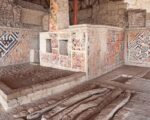Recent archaeological findings in the eastern mountains of Uzbekistan have revealed the remains of two medieval cities, challenging existing narratives about the Silk Road trade routes. This discovery not only uncovers hidden settlements but also enriches our understanding of historical trade dynamics between East and West.
REWRITTEN TEXT
Archaeologists have made a groundbreaking discovery of two ancient cities in the high mountains of eastern Uzbekistan, a finding that could significantly alter our understanding of the legendary Silk Road. Traditionally, the Silk Road has been associated with lowland cities; however, the use of advanced remote sensing technology has led researchers to uncover at least two high-altitude settlements that played a crucial role along the trade routes.
The larger of the two cities, named Tugunbulak, covers over 120 hectares and is situated at an altitude of more than 2,000 meters (6,600 feet). This elevation, once considered inhospitable, has surprised researchers, marking Tugunbulak as a significant urban center from the 8th to the 11th centuries, during a period dominated by a powerful Turkic dynasty. Archaeologist Farhod Maksudov, part of the research team, stated, “The history of Central Asia is now changing with this finding.”
The discovery was made possible through a collaboration between Uzbekistan’s National Center of Archaeology and Washington University in St. Louis, led by Maksudov and Michael Frachetti. Their innovative approach employed drones and a remote-sensing tool called lidar, which utilizes reflected light to generate detailed three-dimensional mappings of the terrain. The research was recently published in the scientific journal Nature and has been hailed for its potential to illuminate the lives of nomadic communities in the region.
The team initially discovered the smaller city, Tashbulak, in 2011 during a trekking expedition. They unearthed burial sites and numerous pottery shards, indicating past habitation. While historical records hinted at cities in the area, the researchers were astonished to find a 12-hectare medieval settlement located at an elevation of about 2,200 meters. “We were kind of blown away,” Frachetti remarked, noting the rough conditions faced during their expeditions, including severe winds and logistical hurdles.
A pivotal moment came in 2015 when a local forestry administrator encouraged the team to explore another site near Tashbulak, revealing that his home was built atop a medieval citadel. “He was living on a huge city,” Frachetti recalled, highlighting the unexpected nature of their findings.
One of the significant challenges the team faced was convincing the academic community of the existence and extent of these highland cities. Frachetti described skepticism from peers, who were doubtful about the scale of their findings, often dismissing them as mere mounds or ruins of lesser significance.
In 2022, the team returned with a drone outfitted with a lidar sensor, allowing them to penetrate the surface and reveal structures such as walls, guard towers, and intricate architectural features in Tugunbulak. The researchers theorize that the communities may have settled in these cities to harness strong winds for iron smelting, as the region is rich in iron ore. Preliminary excavations have also uncovered production kilns, underscoring the area’s historical significance in metal production. “Whoever had iron in their hands in medieval times was very powerful,” Maksudov explained, although he cautioned that this resource exploitation may have contributed to environmental degradation, destabilizing the region.
Traditionally, scholars anticipated settlements to be found in lower valleys, making these high-altitude discoveries particularly remarkable. Professor Peter Frankopan from Oxford University described the findings as a “treasure trove,” revealing deep interconnections across Asia and the historical exploitation of natural resources.
High-altitude urban sites are extremely rare in archaeology due to the unique challenges communities face in such environments. Zachary Silvia, an archaeologist at Brown University, noted that the team’s work represents a significant advancement in our understanding of medieval urbanism in Central Asia, contributing valuable insights into the region’s complex history.


















